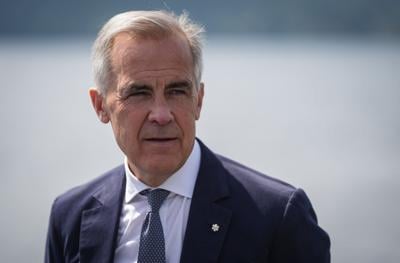Throughout last springŌĆÖs federal election campaign, Mark Carney made liberal use of two very potent slogans from CanadaŌĆÖs political past. The┬Ā ŌĆö about the need for Canadians to become ŌĆ£Masters in our own homeŌĆØ ŌĆö from QuebecŌĆÖs Quiet Revolution. The second ŌĆö a┬Ā to transform the Canadian economy by ŌĆ£taking control of its economic destinyŌĆØ ŌĆö was used in the 1970s and 80s by none other than New Democratic Party leader Ed Broadbent.
Paired with┬Ā that resolved to ŌĆ£get government back in the business of building affordable homesŌĆØ and which included evocative stock footage of postwar housing construction, CarneyŌĆÖs message scanned to many Canadians as bold and progressive ŌĆö promising an activist government with a new spirit of nation-building, and co-operation toward the common good.
To millions of urban progressives and even some would-be Conservative voters as well, it also promised stern resolve in the face of Donald TrumpŌĆÖs threats and a posture of dogged independence from his hard right administration on the world stage. Above all else, a re-elected Liberal government would (unlike PoilievreŌĆÖs Conservatives) use its mandate to protect workers, reinvest in Canadian culture, and develop a more self-reliant economy amid the disintegration of free trade. This was, at least in theory, a sweeping vision for reform anchored in a tough-minded but fundamentally egalitarian liberalism.
Or so it seemed. The Liberal practice of campaigning on the left then governing from the right is, by now, a hallowed Canadian tradition worthy of its own Heritage Minute. But, even to early critics of Carney ), the speed with which his government has spurned the soaring vision of economic patriotism and national renewal that got it elected has been astonishing to behold. With this having apparently served its purpose back in April, a much more conservative ethos has become the governmentŌĆÖs modus operandi.
LetŌĆÖs start with the cuts.
There has always been a certain slipperiness to CarneyŌĆÖs economic rhetoric which has, from the very beginning, leaned heavily on the Goldilocks pledge to ŌĆ£spend lessŌĆØ while ŌĆ£investing more.ŌĆØ And for what itŌĆÖs worth, the government does at least seem intent on keeping one half of this promise.┬Ā
In letters sent out by Finance Minister Fran├¦ois-Philippe Champagne in advance of this fallŌĆÖs federal budget, every minister in cabinet was recently instructed to find ŌĆ£ambitious savingsŌĆØ ŌĆö read: cuts ŌĆö over the next 3 years (in particular areas, the Department for Women and Gender Equality, the cuts look set to be much deeper). The same principle will evidently extend to Crown corporations and other publicly-funded institutions like the CBC ŌĆö which could find its annual funding slashed by up to $198 million over the next three years. Cuts similarly loom at the National Research Council, The Canadian Museum for Human Rights, Statistics Canada, and countless others that play a vital role in civil society (notably, the Canada Border Services Agency, the Department of National Defence, and the RCMP have all been given much lower targets).┬Ā
This is, to say the least, an odd idea of ŌĆ£nation-building.ŌĆØ If enacted, cuts on this scale┬Ā even those made by Stephen Harper and could eliminate┬Ā from the public service. WhatŌĆÖs more, there was little indication during the campaign that such cuts would be coming (the deliberate slipperiness of their campaign rhetoric notwithstanding, the Liberal platform committed to ŌĆ£capping, not cutting, public service employment.ŌĆØ) In record time, it would seem, the governmentŌĆÖs promised new vision of economic nationalism has quickly given way to something more akin to DOGE North, the slash-and-burn ŌĆ£Department of Government EfficiencyŌĆØ in the U.S. initially helmed by Elon Musk.
When it comes to the Carney governmentŌĆÖs abrupt reversals, its budding austerity program is just the beginning. In a fruitless effort to make nice with Donald Trump, it is elsewhere pushing a border bill that has been┬Ā ▓╣▓į╗Õ╠² by Amnesty International as an attack on the rights of those seeking asylum. Taking this futile strategy even further, the government has also capitulated to Trump by┬Ā plans for a Digital Services Tax on Big Tech companies and is reportedly┬Ā signing on to his proposed multibillion-dollar ŌĆ£Golden DomeŌĆØ missile defence initiative.┬Ā
On that latter point, in a┬Ā for the Globe and Mail, former Liberal Minister of Foreign Affairs Lloyd Axworthy summed up the absurdity of the Carney governmentŌĆÖs posture: ŌĆ£After winning an election on a clear promise to assert a more independent foreign and defence policy ŌĆö including a move away from reliance on U.S. weaponry, military strategy and security doctrine ŌĆö this is more than just a baffling development. ItŌĆÖs a betrayal of the vision Canadians voted for.ŌĆØ
Whether you voted Liberal or not, you have to admit Axworthy has a point ŌĆö and itŌĆÖs one┬Ā as well. Taken together, the Carney governmentŌĆÖs approach is one that shares more ground with the right than with the activist spirit of postwar governance that gave us Medicare, public pensions, and the National Housing Program.┬Ā
ItŌĆÖs also one with clear (and dubious) precedent in recent history. In 1993, when the Liberals were returned to power after nearly a decade of Conservative rule, Jean Chr├®tien and Paul Martin duly thanked the electorate with a budget slashed unemployment insurance, gutted social assistance, cut billions from health, education, and other social transfers to provinces and territories, handed pink slips to some 45,000 public servants, and federal funding for affordable housing. Three decades later, these cuts still over our countryŌĆÖs social fabric, living on, as they do, in the likes of underfunded services, weakened infrastructure, deepened social inequality, and an over-financialized housing market that will take decades to repair.┬Ā
Having signalled the opposite in the election campaign last spring, the Carney government evidently hopes to lead Canadians down this same path yet again, into a bold new era of dramatically-reduced social expenditure and trickle down economic development where cuts are sold to us as investments and becoming ŌĆ£Masters in our own homeŌĆØ means nothing more than a deregulated business climate; where itŌĆÖs made easier to┬Ā, millionaires┬Ā │┘│¾▒Š▒░∙╠², and our ŌĆ£economic destinyŌĆØ is something we realize by bending the knee to foreign giants like Google and Netflix; where Ottawa spends┬Ā on security and defence while imposing austerity elsewhere; and, in the face of all this, the government has the audacity to call it ŌĆ£nation-building.ŌĆØ
The tragedy, of course, is that Canada desperately needs the kind of progressive, interventionist approach so many were led to believe a Carney government would bring. Another round of deregulation and pro-corporate policy-making, it hardly needs saying, wonŌĆÖt lower rents or shorten hospital wait times, just as gutting an already underfunded public sector will not magically spur growth or make our democratic institutions stronger. TrumpŌĆÖs threats, by the same token, will not be deterred by a policy of conciliation ŌĆö let alone by new in American military hardware.┬Ā
This is, quite plainly, not the sort of nation-building millions thought they were voting for. If Carney was sold to the electorate as a banker with a social conscience, Carney in practice seems to quite simply be a banker: a technocrat unable or perhaps unwilling to look beyond the discredited market dogmas of the past forty years or envision any proactive role for the federal government in the economy beyond making life easier for large companies and the people who own them (be they Canadian or otherwise). For decades now, this approach ŌĆö and its attendant economic effects ŌĆö has delivered us top-heavy growth, stagnant wages, and depleted social programs. In the United States, and throughout much of Europe, it has helped erode confidence in democratic institutions while weakening civil society and injecting new life into the far right.┬Ā
As a strategy for ŌĆ£nation-buildingŌĆØ it is oxymoronic. But, in a moment of economic turmoil and global uncertainty, it is also one bound to leave us much less well-positioned to weather the storm. ItŌĆÖs been barely three months, but CanadaŌĆÖs new government has already traded wartime stock footage and the slogans of the Quiet Revolution for austerity and cuts without missing a beat. Elbows up, indeed.┬Ā
Error! Sorry, there was an error processing your request.
There was a problem with the recaptcha. Please try again.
You may unsubscribe at any time. By signing up, you agree to our and . This site is protected by reCAPTCHA and the Google and apply.
Want more of the latest from us? Sign up for more at our newsletter page.


























To join the conversation set a first and last name in your user profile.
Sign in or register for free to join the Conversation